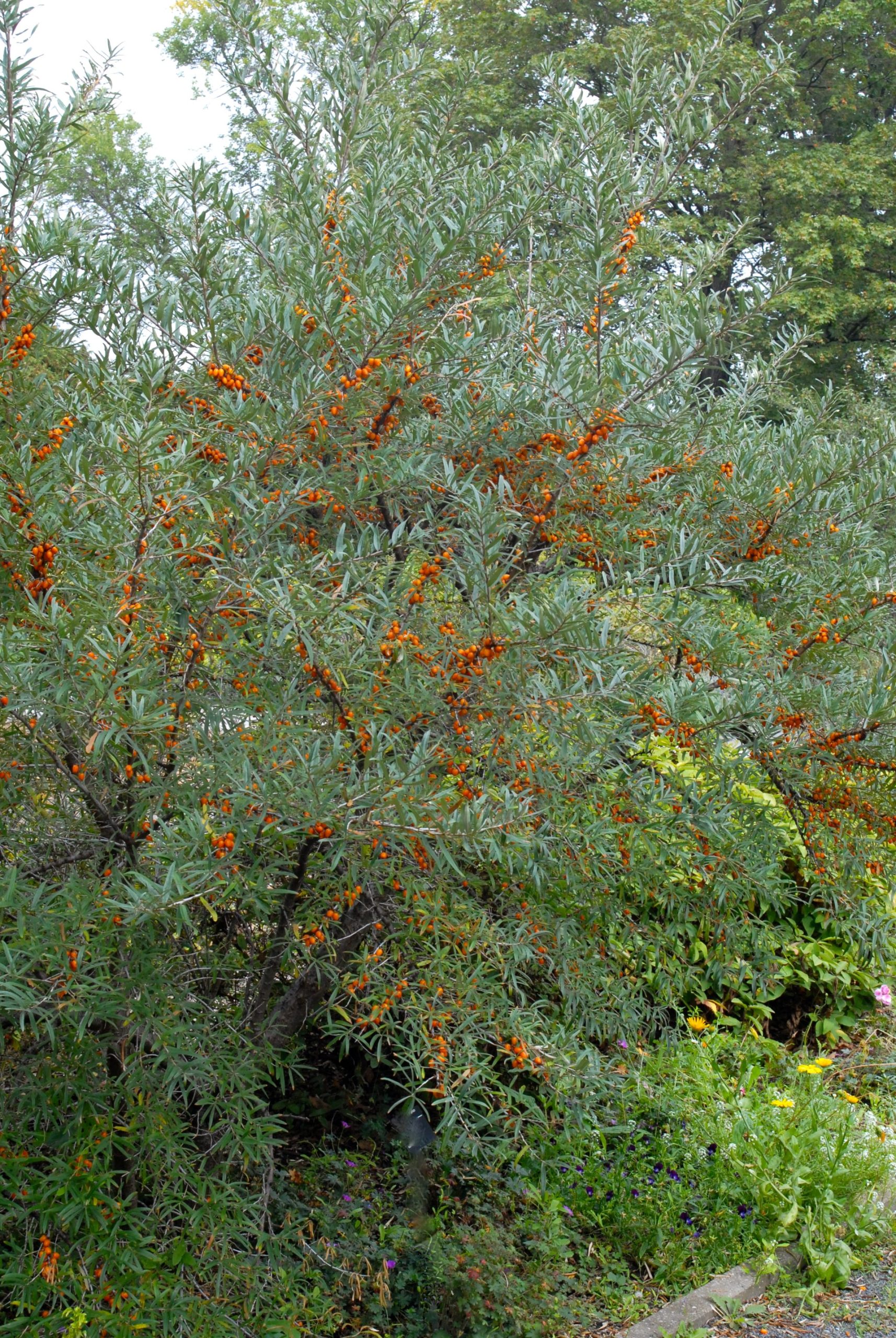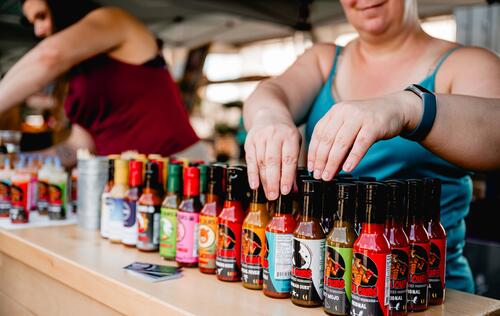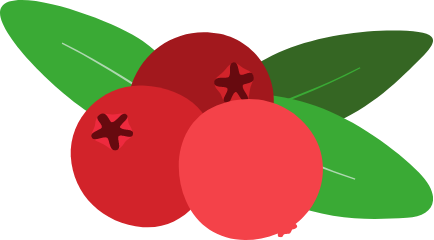Emerging fruit-growing in Quebec

New crops are currently gaining in popularity, particularly among young urban farmers. Emerging crops include some little-known fruit bushes, nuts and hazelnuts, non-timber forest products and energy crops. Here is a description of some of the most promising of these so-called emerging crops.
Buckthorn
Native to the temperate regions of Asia and Europe, Buckthorn is a small, very hardy tree, which sometimes takes the form of a large shrub, growing up to 4 metres high. This species is dioecious, meaning that male and female flowers are borne by separate plants. You therefore need to plant a few female specimens with one or two males together to obtain fruit. In early autumn, the female plants produce innumerable small orange fruits arranged in compact masses on the branches. They are among the most nutritious and vitamin-rich fruits in the plant world.
Buckthorn fruit is particularly rich in vitamins A, B1, B2, C, E, F, K and P, proteins and saturated and unsaturated fatty acids. Among other things, they contain thirty times more vitamin C than oranges! However, Buckthorn fruit is very tart, and some people prefer to add a little sugar before eating it. They also make excellent jellies and jams.
Because it adapts well to all types of soil, including clay, resists drought well and its roots fix atmospheric nitrogen, Buckthorn requires very little care. What’s more, it’s extremely robust and hardy, with the ability to withstand temperatures ranging from -43°C to just over 40°C!
Arctic Kiwi
As well as its pretty white and pink variegated foliage, the Arctic kiwi is a climbing plant that grows to almost 5 metres in height and produces edible fruit. Rich in vitamin C, the fruit of the Arctic Kiwi resembles that of a typical kiwi, but is smaller – about the size of a large grape – with a smooth, hairless skin that is edible and a sweeter taste. Production of Arctic kiwi usually starts four or five years after planting, provided that a male and a female plant are planted close together!
This is because the female flowers – which will produce fruit – are borne on separate plants from the male flowers. For example, ‘Pascha’ is a male variety and ‘September Sun’ is a female Arctic kiwi cultivar that produces well. You should also be aware that the kiwi flowers, which usually open in May, can be affected by late frosts, preventing fruit production. On the other hand, the plant itself is very hardy and can withstand winters as severe as zone 3b. Arctic Kiwis are best planted in full sun or part shade, in compost-rich, cool, well-drained soil. It is also advisable to spread compost at the base of the plants every spring, along with a few handfuls of a natural, slow-release fertiliser rich in nitrogen and potassium (formulation close to 5-3-8).

Goji berries
Also known as lyciet de Barbarie, the goji berry is an indigenous Asian shrub renowned for its vermilion-red fruit and its many medicinal properties. Used in Asia for over three thousand years, the fruit of happiness or eternal youth as the Chinese call it, can be grown in our northern climate, as it is perfectly hardy up to zone 3. The ‘Dynamite’ and ‘Firecracker’ goji cultivars available in some garden centres and nurseries are certainly the most popular. This large shrub with long, arching stems should ideally be planted in humus-rich, loose, cool, well-drained soil.
Honeyberry
The Honeyberry is still little known to amateur gardeners. Yet it is easy to grow, highly productive and particularly hardy. In fact, this shrub can survive a winter temperature of -45°C and its flowers can withstand a frost of -7°C!
The Honeyberry produces small, purplish-blue berries like the blueberry, but with a more elongated, cylindrical shape. Rich in vitamin C and antioxidants, camerises have a flavour reminiscent of both blueberries and raspberries. They can be used for all sorts of purposes: fresh eating, jams, tarts, smoothies, yoghurts, ice cream, sorbets, wine, etc. Another interesting feature is that the camerise is one of the first berries to be picked, ripening in June at the same time as the strawberries.
Vigorous and robust, the Honeyberry is a very undemanding shrub, growing to between 1.2 and 1.8 metres tall, which can be easily grown in the ground or in containers. It adapts well to a variety of soils, from sandy to clay, as long as they are amended with compost, remain cool and are perfectly well drained. With a minimum of six hours of sunshine, the Honeyberry will produce an excellent crop of tasty berries from the very first year, sometimes topping 3 kg per plant after just a few years of cultivation.
The Honeyberry is definitely a northern climate plant, requiring a cold winter. It also prefers a relatively cool summer. During a summer heatwave, this shrub will tend to go into premature dormancy. When this happens, its leaves turn yellow and brown, which may give the impression that it is lacking water or suffering from some kind of disease, when this is simply its way of reacting to the heat. The Honeyberry is perfectly suited to the cool climates of Abitibi, the Laurentians, Charlevoix, Bas-du-Fleuve, Gaspésie and Saguenay-Lac-St-Jean. If your garden is in the Montreal area, be sure to plant this shrub in an east-facing spot, where it won’t be hit too hard by the mid-afternoon sun.
Most experts agree that cultivars from the University of Saskatchewan programme, such as ‘Aurora’, ‘Borealis’, ‘Indigo Gem’, ‘Indigo Treat’, ‘Indigo Yum’ and ‘Tundra’ are the most productive and taste better than most other varieties. Two of the most recent cultivars to emerge from the programme, ‘Boreal Blizzard’ and ‘Boreal Beauty’, have larger, more abundant fruit than older cultivars. As Honeyberry trees are not self-fertile, it is necessary to grow different varieties in close proximity to each other. The cultivars ‘Aurora’, ‘Berry Blue’, ‘Borealis’, ‘Honey Bee’ and ‘Indigo Gem’ are perfectly compatible.

Canadian elderberry
Canadian elderberry is a shrub native to North America. In June, it produces large, creamy-white inflorescences, which then turn into small, crimson-black berries. Edible when ripe and cooked thoroughly, Canadian elderberries make excellent jams and jellies.
The First Nations people attributed several medicinal virtues to elderberry. Some tribes drank infusions of elderberries to combat rheumatism, while others made a wine with invigorating properties. Even today, some herbalists still make an excellent anti-flu syrup from elderberries. This shrub is even of interest to wizards, since it seems that Harry Pother’s magic wand is made from an elder branch!
When fully grown, this large shrub reaches a height of almost 3 metres and a similar width. Although Canadian elderberry is imposing, it is easy to grow in pots because it is undemanding and very hardy – up to zone 4. However, when grown in containers, it usually reaches smaller dimensions. Planted in a large textile pot filled with compost-rich soil in full sun or light shade, Canadian elderberries will produce excellent harvests.

Credits : Albert Mondor




